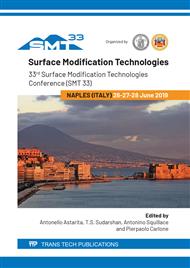[1]
K. Rohit, S. Dixit, A Review - Future Aspect of Natural Fiber Reinforced. Polymer From Renewable Resources, 7, issue 2 (2016) 43-59.
DOI: 10.1177/204124791600700202
Google Scholar
[2]
M. Garcia, I. Garmendia, J. Garcia, Influence of natural fiber type in eco-composites. Journal of Applied Polymer Science. 107 issue 5 (2008) 2994-3004.
DOI: 10.1002/app.27519
Google Scholar
[3]
K. Pickering, M. Aruan Efendy, T. Le, A review of recent developments in natural fibre composites and their mechanical performance, Composite Part. A 83, (2016) 98-112.
DOI: 10.1016/j.compositesa.2015.08.038
Google Scholar
[4]
I. Ashok Kumar, V. Srinivasan, Wear behavior of asbestos-free eco-friendly composites for automobile brake materials. Friction 4 issue 2, (2016) 144-152.
DOI: 10.1007/s40544-016-0111-0
Google Scholar
[5]
L.Boccarusso, A. Viscusi, M Durante, A. Astarita, D. De Fazio, R. Sansone, A. Caraviello, and L. Carrino, Deposition of aluminium coatings on bio-composite laminates, AIP Conference Proceedings 1960 (2018).
DOI: 10.1063/1.5034944
Google Scholar
[6]
L. Boccarusso, M. Durante, A. Langella, F. Memola Capece Minutolo, FE Analysis of Low Density Hemp/Epoxy Composites Produced by a New Continuos Process, Procedia CIRP 67 (2018) 428-433.
DOI: 10.1016/j.procir.2017.12.237
Google Scholar
[7]
A. Astarita, L. Boccarusso, M. Durante, A. Viscusi, R. Sansone, L. Carrino, Study of the Production of a Metallic Coating on Natural Fiber Composite Through the Cold Spray Technique, Journal of Materials Engineering and Perfirmance, 27, issue 2 (2018) 739-750.
DOI: 10.1007/s11665-018-3147-7
Google Scholar
[8]
F. Pinto, M. Meo, Design and manufacturing of a novel shear thickening fluid composite (STFC) with enhanced out-of-plane properties and damage suppression, Applied Composite Materials, 24, issue 3, (2017) 643-660.
DOI: 10.1007/s10443-016-9532-1
Google Scholar
[9]
F. Pinto, M. Meo, Mechanical response of shape memory alloy-based hybrid composite subjected to low velocity impacts, Journal of Composite Materials, 49, issue 22, (2015) 2713-2722.
DOI: 10.1177/0021998314554119
Google Scholar
[10]
C.W. Chin, B.F. Yousif, Potential of kenaf fibres as reinforcement for tribological applications. Wear 267(2009) 1550–1557.
DOI: 10.1016/j.wear.2009.06.002
Google Scholar
[11]
J. Holbery, D. Houston, Natural - fibre - reinforced polymer composites in automotive applications. Journal of the Minerals, Metals & Materials Society 58 issue 11, (2006) 80-86.
DOI: 10.1007/s11837-006-0234-2
Google Scholar
[12]
C. Menna, D. Asprone, M. Durante, A. Zinno, A. Balsamo, A. Prota, Structural behavior of masonry panels strengthened with an innovative hemp fibre composite grid, Construction and Building Materials 100, (2015) 111-121.
DOI: 10.1016/j.conbuildmat.2015.09.051
Google Scholar
[13]
C. Chin, B. Yousif, Potential of kenaf fibres as reinforcement for tribological applications. Wear 267, (2009) 1550–1557.
DOI: 10.1016/j.wear.2009.06.002
Google Scholar
[14]
N. Chand, U.K. Dwivedi, Influence of fiber orientation on high stress wear behavior of sisal fiber-reinforced epoxy composites,Polymer Composites 28 issue 4, (2007) 437-441.
DOI: 10.1002/pc.20286
Google Scholar
[15]
F. Rubino, P. Ammendola, A. Astarita, F. Raganati, A. Squillace, A. Viscusi, R. Chirone, L. Carrino, An innovative method to produce metal foam using Cold Gas Dynamic Spray process assisted by fluidized bed mixing of precursors, Key Engineering Materials, 651-653, (2015) 913-918.
DOI: 10.4028/www.scientific.net/kem.651-653.913
Google Scholar
[16]
L. Boccarusso, M. Durante, A. Langella, Lightweight hemp/bio-epoxy grid structure manufactured by a new continuous process, Composite part B: Engineering, 146 (2018) 165-175.
DOI: 10.1016/j.compositesb.2018.04.009
Google Scholar
[17]
R. Sepe, F. Bollino, L. Boccarusso, F. Caputo, Influence of chemical treatments on mechanical properties on hemp fiber reinforced composites, Composite part B: Engineering, 133 (2018) 210-217.
DOI: 10.1016/j.compositesb.2017.09.030
Google Scholar


